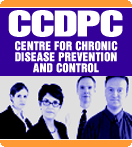![]()



|
|
||||||||||||


 |
|
|||||||||||

|

Type 2 DiabetesType 2 diabetes occurs when insulin continues to be produced but, for a variety of reasons, is not properly used in the body. Type 2 usually occurs later in life and affects 90 percent of people with diabetes (people are typically diagnosed with Type 2 after the age of 45). In recent years, however, more and more cases of type 2 diabetes are coming to light in young people, especially those of Aboriginal descent. Those with a family history of obesity and inactivity are also at risk for developing type 2 diabetes. As such, this type of diabetes can be prevented. Symptoms Clues to the presence of type 2 diabetes include:
A person may also present evidence of the complications of diabetes to their physician. These can include:
Prevention Type 2 diabetes can be insidious, continuing to gain ground without any obvious signs or symptoms. As a result diagnosis may be delayed until complications begin to surface. Anyone at risk or exhibiting early symptoms should consult a physician. Early and tight control of blood sugar levels combined with control of high blood pressure and blood lipids can reduce the risk of complications. |
||||||||||||||||||||||||||||||||||||||
|
|||||||